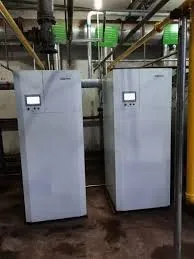Նյմ . 24, 2024 17:38 Back to list
tube in tube cooler
Tube-in-Tube Coolers An Efficient Solution for Heat Exchange
In various industrial applications, effective heat exchange is crucial for maintaining operational efficiency and safety. One innovative solution that has gained traction in recent years is the tube-in-tube cooler. This technology is recognized for its compact design, efficient heat transfer capabilities, and versatility, making it an essential component in many heat-exchanging processes.
What is a Tube-in-Tube Cooler?
A tube-in-tube cooler consists of two concentric tubes—an inner tube and an outer tube. The fluid that needs to be cooled flows through the inner tube, while a cooling medium, such as water or another coolant, flows in the annular space between the two tubes. This configuration allows for a highly effective heat exchange process due to the increased surface area and the fact that the two fluids flow in opposing directions (counterflow), which maximizes the temperature gradient and enhances heat transfer efficiency.
Advantages of Tube-in-Tube Coolers
1. Compact Design One of the standout features of tube-in-tube coolers is their compact size. Unlike traditional shell-and-tube heat exchangers, tube-in-tube designs are more space-efficient, making them ideal for installations where space is limited.
2. High Efficiency The design of the tube-in-tube cooler facilitates a very high rate of heat transfer. The counterflow arrangement ensures that the maximum temperature differential is maintained across the length of the exchanger, leading to more effective cooling.
3. Versatility Tube-in-tube coolers can handle a wide range of fluids and are suitable for various applications, including HVAC systems, refrigeration, chemical processing, and oil cooling. Their adaptability makes them a popular choice across multiple sectors.
tube in tube cooler

4. Maintenance and Cleaning The simple structure of tube-in-tube coolers makes them easier to maintain and clean compared to other heat exchangers. This is particularly important in industries where fouling can significantly reduce efficiency. Regular maintenance can help sustain operational efficiency over time.
5. Durability and Longevity Made from durable materials, tube-in-tube coolers can withstand high pressures and temperatures, ensuring a long operational life. This durability is essential, particularly in industries where equipment failure can lead to costly downtimes and safety hazards.
Applications of Tube-in-Tube Coolers
Given their advantages, tube-in-tube coolers are employed in an array of applications. In the food and beverage industry, they are used for pasteurization and cooling processes, ensuring that products are heated and cooled efficiently without compromising quality. In the chemical sector, they serve as essential components for reactor cooling and process temperature control.
Moreover, in the energy sector, these coolers are used in power plants and other energy generation processes to manage the temperature of fluids effectively. Their ability to adapt to different fluid types makes them indispensable in optimizing performance across various industries.
Conclusion
The tube-in-tube cooler represents a significant advancement in heat exchange technology, offering a range of benefits that make it a preferred choice in many applications. Its compact design, high efficiency, and versatility enhance its appeal among engineers and designers looking for reliable heat exchangers. As industries continue to seek improved efficiency and sustainability, tube-in-tube coolers will undoubtedly play a vital role in enhancing heat exchange processes worldwide.
-
Durable Centrifugally Cast Iron Water Main Pipe
NewsAug.11,2025
-
Centrifugally Cast Iron Water Main Pipes for Reliability
NewsAug.10,2025
-
High-Quality Centrifugally Cast Iron Water Main Pipes
NewsAug.09,2025
-
Durable Cast Iron Water Main Pipe & Drainage Solutions
NewsAug.08,2025
-
Buy Cast Iron Pipe: Premium Ductile Iron & Drain Solutions
NewsAug.07,2025
-
Durable Cast Iron Water Main Pipe | Buy Ductile Pipe
NewsAug.06,2025


